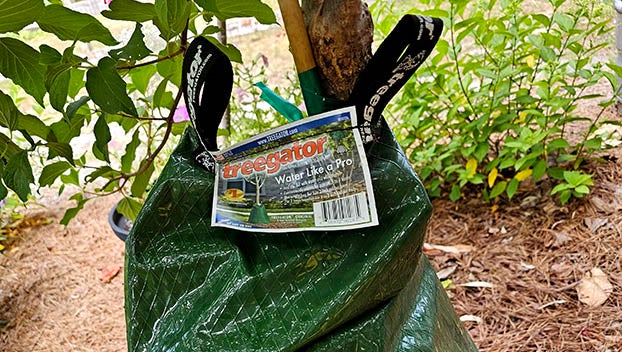Through the Garden Gate: It’s too hot in the garden
Published 2:46 pm Sunday, July 14, 2024

- Rattlesnake master is a native plant that grows well in hot, dry weather.
|
Getting your Trinity Audio player ready...
|
We’ve had day after day of temperatures above 90F, and the heat has taken a toll on both humans and plants. We’re all singing Cole Porter’s “It’s Too Darn Hot” and desperately looking for relief.
A quick walk around my garden reveals that the crocosmia leaves are turning brown, most daylily blooms are discolored before noon, and the hydrangeas are droopy and sad looking. In the vegetable garden, the tomatoes are dropping leaves, the leeks are yellowing, and the peppers aren’t setting fruit. Only the okra is thriving. Clearly some action is needed to get us all through the current hot, dry spell.

Treegators make deep watering of trees easier and more effective.
Two of the most important steps a gardener can take are watering and mulching. Watering is needed to keep many plants, especially those that were recently transplanted or are growing in containers, from dying. Mulching helps retain moisture, thus reducing the need for frequent watering.
Because my garden covers over half an acre, watering requires some planning to conserve resources and human energy. Watering early in the morning or in the evening reduces the amount of water lost to evaporation. Watering in the morning, however, is slightly more advantageous because plants have time to dry off before the sun sets, thus reducing the incidence of root rot and fungal infections.
Equally important is the amount of water provided. Deep watering, rather than frequent but light watering, allows plants to grow deeper roots and means that the gardener doesn’t have to water as frequently. How much water? The general guideline is to provide an inch of water per week. Some local Master Gardeners have suggested burying an empty tuna can in the soil near plants being watered. When the can is full, then an inch of water has generally been provided to the plants.
Plants growing in pots and hanging baskets require extra attention. Their growing medium tends to dry out very quickly, especially if the containers are small. Be sure to check container plantings at least once every day and water them thoroughly before the plants become stressed.
As for mulching, it should be put down when plantings are being established and then checked annually. A general guideline is to use organic materials, such as straw, pine needles, shredded leaves, and bark nuggets or chips, and to apply 2 to 4 inches. Some gardeners use grass clippings, but clippings tend to mat together and prevent moisture from reaching the soil. Mulch should not be applied up against tree trunks, called volcanoing, because it encourages the growth of diseases.
Watering and mulching are good general approaches to dealing with short periods of hot, dry weather. If our summer weather becomes more extreme, however, we gardeners may be forced to change the way we garden by planting more drought-resistant plants, especially natives. We may have to give up our lush, green lawns too. In the meantime, stay safe. Don’t work in the garden during the hottest hours of the day, drink lots of water, wear sunscreen and a hat, and take it easy.
Dr. Cynthia Wood is a master gardener. Her email address is cynthia.crewe23930@gmail.com.





